Overview
Shibumi makes it easy to create and view your data. From Lists and Views, you can do the following:

- Refresh: Refresh a specific section to return new data. New data is available when the Refresh icon is blue.
- Report View: View data in a tabular format.
- Gantt Chart: View a time-based graphical representation of Start and Due dates. The colors are tied to the out-of-the-box Status attribute.
- Charts: View data in a variety of charts (available charts are dependent on the configuration of your section).
- Filter: Filter a List/View based on an attribute or role.
- Sort: Sort a List/View by recently updated or by columns in the section.
- Settings: Export and Bulk Edit options are available within the Settings menu.
- Create: Add to a List by selecting the + button and adding one or multiple items. This option is not available on Views.
Section icons are available on hover of the upper right corner of Lists/Views. The Create button (plus icon) is always displayed on Lists.
Report View

- Edit: Ability to edit an item (that you have permissions to edit) by selecting inside a cell and changing the value.

- Export: Generates a CSV file that downloads immediately to your computer. The file will only include columns on the List/View. If the hide filter is on, it will not show the hidden columns.
- Export On: Schedule an Export to run on a recurring cadence. View all scheduled exports on your My Account page.
- Bulk Edit: Allows users to bulk edit Lists or Views of data.
Note: Exporting may not be available in your solution.
Chart View
Depending on the List/View type and configuration, you will have different chart types available.
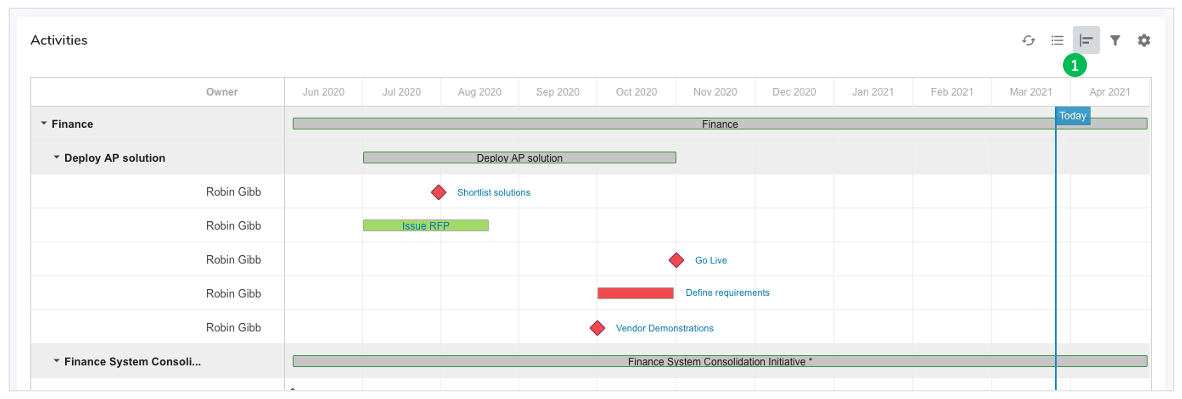
- Gantt Chart
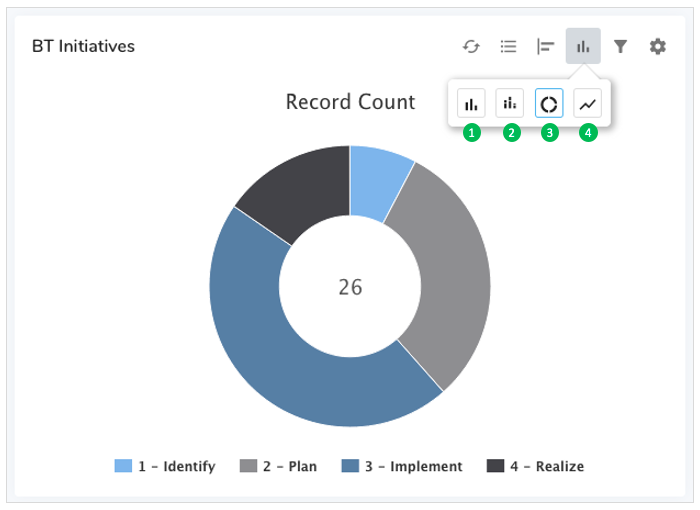
Char
- Bar Chart
- Stacked Bar Chart
- Donut Chart
- Line Chart
Filters
In any List or View of data, there is the ability to filter data by selecting the filter icon. The filter icon is located at the top right of the section. Clicking on it reveals the filter bar with the ability to type into or select values for unlocked filters. Typing text into a filter field will search for any items whose value contains that text.
In the below example, the Type filter is locked. Progress is filtered to show any item whose Progress value contains Completed.
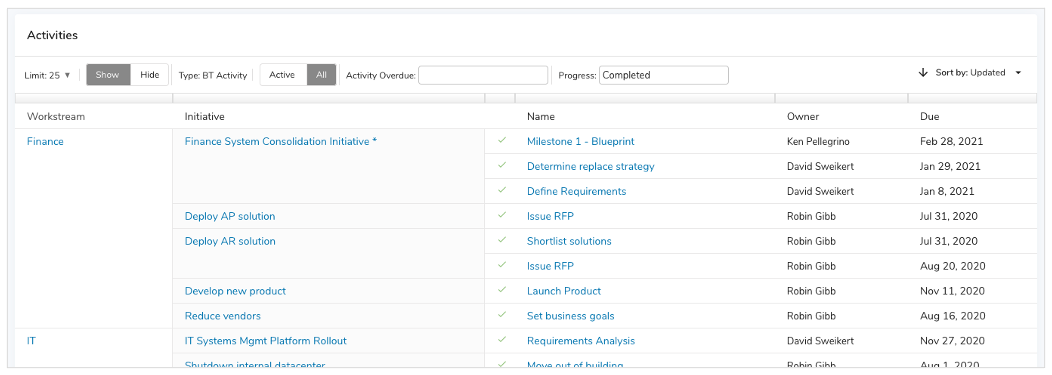
Dropdown Filters
| Filter Name | Meaning |
| Limit |
|
| Type |
|
Dynamic Filters
Admins and end users can define dynamic filters by entering expressions in a text or numeric filter. These allow you to provide an expression that determines the value that will be used for the filter.
A dynamic filter is composed of a brace, an exclamation point, an expression, and closed by a brace. These can be combined within a filter using a space, comma, or plus sign.
Examples:
- {!Stage__c}
- Project {!name}
- {!days(creationDate, finishDate)}
- {!max(10, Employee_Headcount__c)}
- {!Business_Unit__c} + {!Phase__c}
If you want to reference an ancestor attribute, you can do so by prefixing the reference with the template API name of the template containing the attribute. If the reference is to an attribute on the immediate parent or grandparent ancestor, you can use parent or parentOfParent as the prefix.
Examples:
- {!parent.Stage__c}
- {!parentOfParent.Stage__c}
- {!Initiative__t.Stage__c}
Attribute references in the dynamic filter expressions must use their API name, which can be found on the Data panel on a template or in the Info dialog launched from the actions menu on your instance. If you are not an instance Admin or App Admin and do not have access to templates, please contact an Admin for this information.
Note: Exact filtering can be used for Dynamic Filters as well by surrounding the expression in double quotes, i.e. “{!Stage__c}”.
Toggle Filters
Some attribute filters are displayed as toggles rather than text, numeric, or date fields.
| Filter Name | Meaning |
| Active/All |
|
| Show/ Hide |
|
Filter Operators
Operators specify how filter criteria relate to one another. Refer to this list of filter operators when setting filters.
| Action | Operator | Meaning | Supported Filter Type(s) |
| OR | Comma-separated (,) | Filters on any of the values entered | Text, Numeric |
| AND | Plus sign separated (+) | Filters on a combination of values | Text, Numeric |
| Exact Match | Surround values in quotes e.g. “Insert Values” | Returns results matching all entered values | Text, Numeric |
| Empty Values | Enter double quotes e.g. “” | Filters on fields containing no value | Text, Numeric |
| Less Than | < | Evaluates if a value is less than the value that follows this symbol | Numeric |
| Greater Than | > | Evaluates if a value is greater than the value that follows this symbol | Numeric |
| Less or Equal | <= | Evaluates if a value is less than or equal to the value that follows this symbol | Numeric |
| Greater or Equal | >= | Evaluates if a value is greater than or equal to the value that follows this symbol | Numeric |
| Not Equal to | != | Excludes values from your results | Text, Numeric |
Sort
Users are able to sort their Lists and Views with our Sort By options. In the Sort By drop-down, users may select one or more columns to Sort By. If you would like to sort items by ascending or descending order, simply click on the arrow next to the item to toggle the sort order direction.
Notes:
- Column headers and Updated date are available as Sort By options.
- When sorting, blanks will always appear at the bottom, after values.
Create
Users are able to add items to a List by selecting the plus icon in the upper right-hand corner. This option is not available on Views.
The Create New option allows users to create a single item.
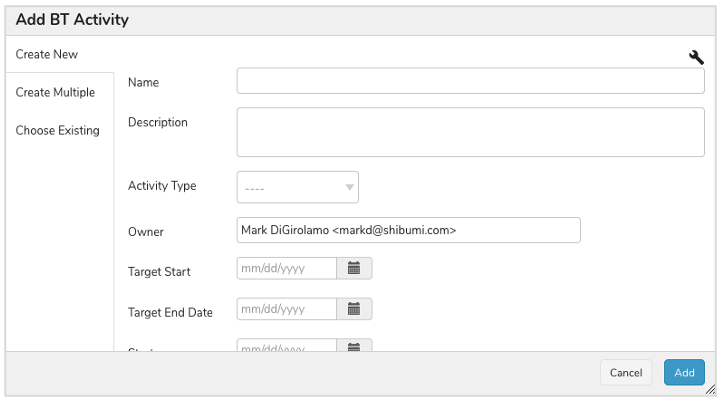
The Create Multiple option allows users to bulk create items.
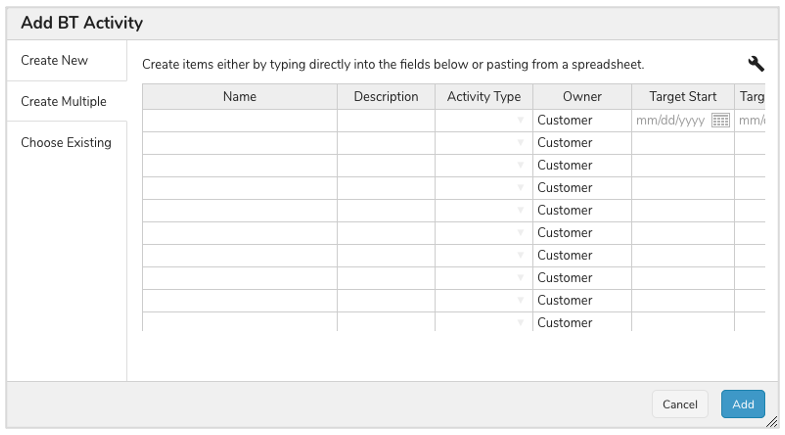
Export
To manually export data from a List or View section, simply select the Settings gear icon at the top right of the section and select “Export” from the drop-down options.
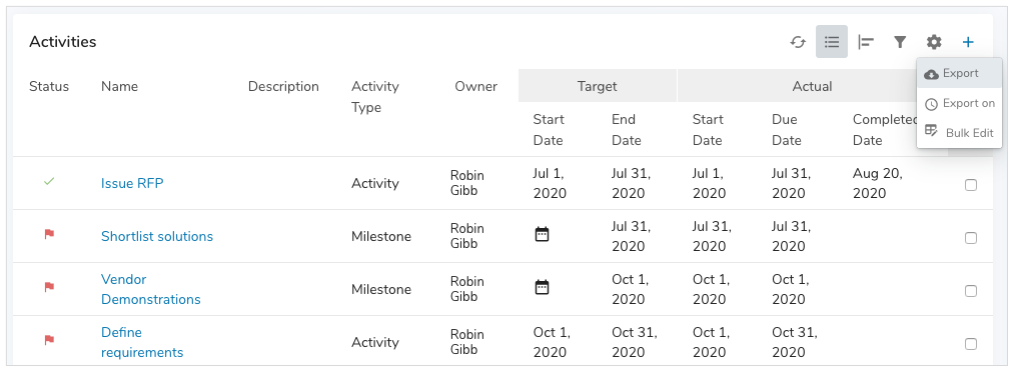
Data is exported based on filter and sort order configurations. All available results are returned regardless of the Limit filter configuration.

When you open the exported file in Excel, the structure of the columns will match the structure from the List/View.
Note: If you’d like to export in a different format, please change your account settings in User Account Settings. Learn more about exporting here.
To schedule an export, click “Export on” to open the scheduling dialog. Select a start date, cadence (weekly or monthly), and frequency (e.g., every 2 weeks on Friday). To cancel a scheduled export from the section, open the scheduling dialog and select Cancel Schedule in the bottom left corner.

When a scheduled export runs, it only takes locked filters into account. Exports can only be scheduled when the Type filter is locked. If a type filter becomes unlocked after scheduling, the export will not complete.
To view all of your existing scheduled exports, go to your Account page by hovering over the user icon in the Navigation Sidebar and selecting My Account.
Note: Exporting may not be available in your solution.
Bulk Edit
To bulk edit the content in a list or view, select the Settings gear icon at the top right of the section and select “Bulk Edit” from the drop-down options.
The section will toggle to Bulk Edit mode. You can manually edit the rows of data or you can paste in rows of data from a CSV file (e.g., Excel). The column order and data types of the CSV file must match the column order and data types of the list or view in Shibumi.
Existing content will be updated with the pasted values.
For Lists, users can also add additional rows of content. When this is pasted into Shibumi, new work items will be created for each row that was added.

